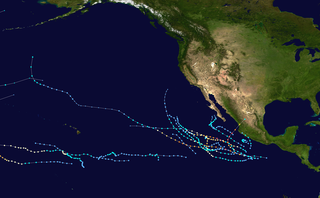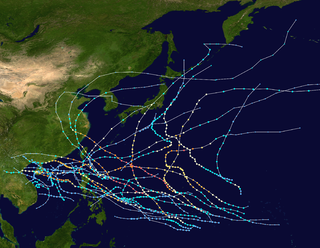Accumulated cyclone energy (ACE) is a measure used by various agencies including the National Oceanic and Atmospheric Administration (NOAA) and the India Meteorological Department to express the activity of individual tropical cyclones and entire tropical cyclone seasons. It uses an approximation of the wind energy used by a tropical system over its lifetime and is calculated every six hours. The ACE of a season is the sum of the ACEs for each storm and takes into account the number, strength, and duration of all the tropical storms in the season. The highest ACE calculated for a single storm is 82, for Hurricane/Typhoon Ioke in 2006.

The 2003 Pacific hurricane season was the first season to feature no major hurricanes – storms of Category 3 intensity or higher – since 1977. It produced an unusually large number of tropical cyclones which affected Mexico. The most notable cyclones during the year were Hurricanes Ignacio and Marty, which killed 2 and 12 people in Mexico, respectively, and were collectively responsible for about US$1 billion in damage. Three other Pacific storms, two of which were hurricanes, and three Atlantic storms also had a direct impact on Mexico. The only other significant storm of the season was Hurricane Jimena, which passed just to the south of Hawaii, the first storm to directly threaten Hawaii for several years.

The 2002 Pacific hurricane season was a slightly above average Pacific hurricane season that saw three tropical cyclones reach Category 5 intensity on the Saffir–Simpson scale, tied for the most in a season with 1994 and 2018. The strongest storm this year was Hurricane Kenna, which reached Category 5 on the Saffir–Simpson scale. It made landfall near Puerto Vallarta, located in the Mexican state of Jalisco, on October 25. Elsewhere, Tropical Storm Julio made landfall in Mexico, and Tropical Storm Boris dumped torrential rain along the Mexican coast, despite remaining offshore.

The 2000 Pacific hurricane season was an above-average Pacific hurricane season, although most of the storms were weak and short-lived. There were few notable storms this year. Tropical Storms Miriam, Norman, and Rosa all made landfall in Mexico with minimal impact. Hurricane Daniel briefly threatened the U.S. state of Hawaii while weakening. Hurricane Carlotta was the strongest storm of the year and the second-strongest June hurricane in recorded history. Carlotta killed 18 people when it sank a freighter. Overall, the season was significantly more active than the previous season, with 19 tropical storms. In addition, six hurricanes developed. Furthermore, there were total of two major hurricanes, Category 3 or greater on the Saffir–Simpson hurricane wind scale.

The 1994 Pacific hurricane season was the final season of the eastern north Pacific's consecutive active hurricane seasons that unofficially started in 1982. The season officially started on May 15, 1994, in the eastern Pacific, and on June 1, 1994, in the central Pacific, and lasted until November 30, 1994. These dates conventionally delimit the period of each year when most tropical cyclones form in the northeastern Pacific Ocean. The first tropical cyclone formed on June 18, while the last system dissipated on October 26. This season, twenty-two tropical cyclones formed in the north Pacific Ocean east of the dateline, with all but two becoming tropical storms or hurricanes. A total of 10 hurricanes occurred, including five major hurricanes.

The 1992 Pacific hurricane season is the most active Pacific hurricane season on record, featuring 27 named storms, and the second-costliest Pacific hurricane season in history, behind the 2013 season. The season also produced the second-highest ACE value on record in the basin, only surpassed by the 2018 season. The season officially started on May 15 in the eastern Pacific, and on June 1 in the central Pacific, and lasted until November 30. These dates conventionally delimit the period of each year when most tropical cyclones form in the northeastern Pacific Ocean. However, these bounds were easily exceeded when Hurricane Ekeka formed on January 28 and again a couple months later with Tropical Storm Hali.

The 1988 Pacific hurricane season was a Pacific hurricane season that saw a below-average amount of tropical cyclones form, the first time since 1981. It officially began May 15, in the eastern Pacific, and June 1, in the central Pacific and lasted until November 30. These dates conventionally delimit the period of each year when most tropical cyclones form in the northeastern Pacific Ocean. The first named storm, Tropical Storm Aletta, formed on June 16, and the last-named storm, Tropical Storm Miriam, was previously named Hurricane Joan in the Atlantic Ocean before crossing Central America and re-emerging in the eastern Pacific; Miriam continued westward and dissipated on November 2.

The 1984 Pacific hurricane season was a very active season, producing 21 named storms. When Fausto became a tropical storm on July 3, it was the earliest the sixth named storm was named. This record would be tied in 1985 and broken 34 years later. The season produced 26 tropical cyclones, of which 21 developed into named storms; 13 cyclones attained hurricane status, of which three reached major hurricane status. The season officially started on May 15, 1984, in the eastern Pacific, and June 1, 1984, in the central Pacific, and lasted until November 30, 1984. These dates conventionally delimit the period of each year when the vast majority tropical cyclones form in the northeastern Pacific Ocean. The strongest hurricane of the season was Hurricane Douglas, which attained Category 4 status on the Saffir-Simpson Hurricane Scale in the open Pacific.

The 1980 Pacific hurricane season officially started May 15, 1980, in the eastern Pacific and June 1, 1980, in the central Pacific, lasting until November 30, 1980. These dates conventionally delimit the period of each year when most tropical cyclones form in the northeastern and central Pacific Ocean. This season was relatively uneventful; since no tropical cyclones made landfall, there were no reports of casualties or damage.
The name Helga has been used for three tropical cyclones in the Eastern Pacific Ocean.

The 1974 Pacific hurricane season featured one of the most active periods of tropical cyclones on record with five storms existing simultaneously. The season officially started May 15 in the eastern Pacific, and June 1 in the central Pacific, and lasted until November 30. These dates conventionally delimit the period of each year when most tropical cyclones form in the northeast Pacific Ocean.

A Pacific hurricane is a mature tropical cyclone that develops within the eastern and central Pacific Ocean to the east of 180°W, north of the equator. For tropical cyclone warning purposes, the northern Pacific is divided into three regions: the eastern, central, and western, while the southern Pacific is divided into 2 sections, the Australian region and the southern Pacific basin between 160°E and 120°W. Identical phenomena in the western north Pacific are called typhoons. This separation between the two basins has a practical convenience, however, as tropical cyclones rarely form in the central north Pacific due to high vertical wind shear, and few cross the dateline.

The 1978 Pacific hurricane season officially began May 15, 1978, in the eastern Pacific, June 1, 1978, in the central Pacific, and officially ended on November 30, 1978. These dates conventionally delimit the period of time when tropical cyclones form in the eastern north Pacific Ocean.

The 1970 Pacific hurricane season began on May 15, 1970 in the east Pacific, and on June 1, 1970 in the central Pacific. It ended on November 30, 1970. These dates conventionally delimit the period of time when tropical cyclones form in the eastern Pacific Ocean.

The 1953 Pacific typhoon season has no official bounds; it ran year-round in 1954, but most tropical cyclones tend to form in the northwestern Pacific Ocean between June and December. These dates conventionally delimit the period of each year when most tropical cyclones form in the northwestern Pacific Ocean.

The 1966 Pacific hurricane season started on May 15, 1966, and ended November 30, 1966. The season was of little note. Hurricane Blanca traveled 4,300 miles, setting a new record. During September and October of the year, Hurricane Helga and Tropical Storms Kirsten, Lorraine, and Maggie hitting Mexico. Kirsten caused 8 deaths and US$5.6 million in damages in Mexico.

The 1970–71 South-West Indian Ocean cyclone season was an above-average cyclone season. The season officially ran from November 1, 1970, to April 30, 1971.

The 2018 Pacific hurricane season produced the highest accumulated cyclone energy value on record in the basin. With 23 named storms, it was the fourth-most active season on record, tied with 1982. The season also featured seven landfalls, six of which occurred in Mexico. The season officially began on May 15 in the eastern Pacific, and on June 1 in the central Pacific; they both ended on November 30. These dates conventionally delimit the period of each year when most tropical cyclones form in the Pacific basin. However, tropical cyclone formation is possible at any time of the year, as illustrated when the first tropical depression formed on May 10, five days prior to the official start of the season.

The 2019 Pacific hurricane season is an ongoing event in the annual cycle of tropical cyclone formation, in which tropical cyclones form in the eastern Pacific Ocean. The season officially began on May 15 in the East Pacific Ocean, and on June 1 in the Central Pacific; they will both end on November 30. These dates conventionally delimit the period of each year when most tropical cyclones form in the Pacific basin. However, the formation of tropical cyclones is possible at any time of the year. The season had a slow start, with no tropical cyclones forming in the basin during the month of May for the first time since 2016, and the first time that no storms formed before the month of June since 2011. The season became the latest-starting Pacific hurricane season on record since reliable records began in 1971, with the first tropical depression forming on June 25. For the first time since 1973, no hurricanes formed in the basin in the month of August.

















